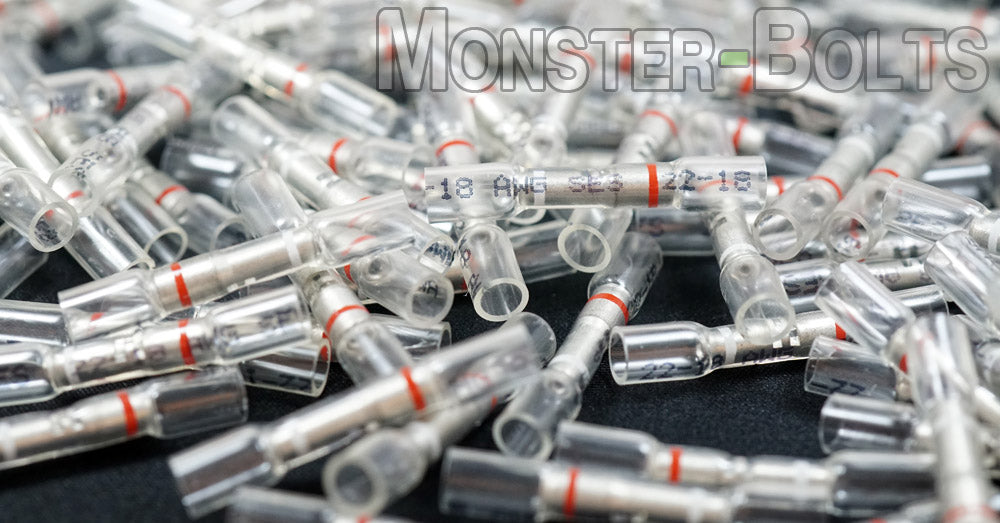A practical guide to picking the right level of sealing—without over-engineering your project.
What is an Environmental Seal?
An environmental seal protects connections from water, dust, oils, and salt—ideal for automotive, marine, outdoor lighting, appliances, and general industrial. Typical solutions include:
- Adhesive-lined heat-shrink (marine-grade crimp/solder butt connectors)
- Grommeted housings and O-rings in connector shells
- Ingress protection targeting IP67/IP68 (temporary or continuous immersion as specified)
When to use: Splash zones, washdown areas, engine bays, bilges, outdoor junctions—any place you need reliable moisture and contamination resistance without vacuum/pressure constraints.
What is a Hermetic Seal?
A hermetic seal is an airtight barrier—commonly achieved with glass-to-metal or ceramic-to-metal construction—to meet extremely low leak rates (helium-tested). These are used when even trace gas or moisture ingress is unacceptable.
When to use: Vacuum systems, spacecraft, deep-pressure environments, implantable/medical devices, and long-life instrumentation where permeation and outgassing must be tightly controlled.
Choose Wisely: A Simple Decision Framework
- Vacuum/pressure? Yes → consider hermetic. No → environmental seal is likely sufficient.
- Immersion depth/duration? Match your IP rating (IP67 temporary immersion, IP68 continuous per manufacturer spec).
- Chemicals/temperature? Confirm jacket/adhesive and connector materials suit your environment.
| Scenario | Recommended Seal | Notes |
|---|---|---|
| Automotive/Marine wiring, splash or submersion | Environmental (IP67/IP68) | Adhesive-lined heat-shrink butt splices or sealed housings |
| Outdoor lighting & junctions | Environmental | UV-resistant heat-shrink; ensure strain relief |
| Vacuum, high altitude, spacecraft, implants | Hermetic | Glass/ceramic-to-metal; helium-leak spec; controlled assembly |
When a Sealed Butt Splice Is All You Need
For most field splices, an adhesive-lined, heat-shrink butt connector delivers a robust environmental seal with fast, repeatable installs. It’s the go-to for boats, vehicles, and outdoor electronics.


Browse our full lineup here: Sealed Electrical Connectors.
Installation Best Practices (Quick Guide)
- Strip insulation to spec; avoid nicking strands.
- Crimp with the correct die for the connector size (don’t use pliers).
- Heat with an appropriate tool (no open flame if possible) until adhesive flows and the sleeve fully recovers.
- Support the cable: add strain relief and avoid sharp bends near the splice.
- Inspect & test: light pull test; continuity test; if applicable, a brief immersion/splash test.
FAQs
Do I need hermetic seals for marine wiring?
No. Marine projects only need environmental seals, which protect against water, salt, and debris. Hermetic seals are overkill unless you’re working on submarines or aerospace systems.
What does IP rating mean on sealed connectors?
IP (Ingress Protection) ratings describe resistance to dust and water. For most outdoor or marine wiring, an IP67 or IP68 rated environmental connector is sufficient.
How do I install sealed butt connectors for a long-lasting splice?
Use the correct size connector, crimp with a proper ratcheting tool, then apply uniform heat until the sleeve fully recovers and the internal adhesive visibly wets to the insulation. Add strain relief and test continuity.
Are heat-shrink sealed connectors better than standard crimp connectors?
For wet, dirty, or corrosive environments—yes. Adhesive-lined heat-shrink provides a moisture barrier and mechanical support that standard crimps lack. In clean, dry enclosures, a quality non-sealed crimp may be sufficient.
What should I use for marine-grade wiring?
Use tinned copper wire and adhesive-lined heat-shrink connectors rated for your gauge, with proper strain relief. Avoid dissimilar-metal contact when possible and seal all splices against saltwater ingress.

